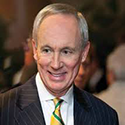
Opinions expressed in AGB podcasts are those of the speakers and not necessarily those of the organizations that employ them or of AGB.
What do governing boards need to know to protect their institutions’ missions and values during these politically charged times? Constitutional scholar, former University of Vermont President, and AGB Board Member Tom Sullivan discusses the legal challenges facing higher education today with AGB’s Vice President for Content Strategy and Development Doug Goldenberg Hart.
Aired: June 30, 2025
Podcast Transcript
Introduction:
Welcome to the Trusteeship Podcast from AGB, the Association of Governing Boards of Universities and Colleges. We cover everything higher education leaders need to know about the challenges facing our nation’s colleges and universities. More important, we provide the facts and insight you need to solve those challenges and to be the storytellers and advocates higher education needs.
Today, we’re talking about how recent federal actions are reshaping the landscape for colleges and universities. We’re joined by constitutional scholar and former University of Vermont President Tom Sullivan to talk about the legal challenges facing higher education today. AGB’s Vice President for Content Strategy and Development Doug Goldenberg Hart discusses with Tom what governing boards need to know to protect their institutions’ missions and values during these politically charged times. Let’s get started, Doug.
Doug Goldenberg-Hart:
In this episode, we’re sitting down with renowned Constitutional scholar, AGB board member, and former University of Vermont president, E. Thomas Sullivan to explore the legal battles that are defining the Trump administration’s clash with higher education. From immigration restrictions on international students to rollbacks of Title IX protections, and from attacks on affirmative action to executive threats tied to free speech, federal actions have triggered a wave of lawsuits and a remarkable number of immediate injunctions at the lower court level. We’ll discuss today the federal legal and constitutional principles that are at stake, why so many Trump era directives are facing legal roadblocks, how courts acted as a check on executive power, and what university leaders must learn from this moment. Tom, thank you for joining us.
Tom Sullivan:
My pleasure. Thank you.
Doug Goldenberg-Hart:
Can you share some of your background, especially as it relates to academic leadership and constitutional law?
Tom Sullivan:
Yes, I have had the pleasure of serving for 30 years in higher education administration, twice a law school dean, provost, and president of a university. I’ve also served on five different higher education boards, including, as you said, AGB’s board as well. I have been a law school faculty member for 25 years, and I’ve taught over 4,000 law students during that period of time; co-authored or authored 14 books, most recently, in the last 15 years, on constitutional history and constitutional law. And before joining the academy, I practiced law for six years, first as a federal prosecutor at Department of Justice here in Washington, and then with a large law firm as a litigator. And since I have stepped out of the presidency of the University of Vermont, I’ve been a visiting law faculty member of University of California Berkeley, New York University Law School, Georgetown Law School, and Cambridge University in United Kingdom.
Doug Goldenberg-Hart:
Wow. Lot of background and a perfect person to have this conversation with at this moment. What are the most significant federal legal challenges currently facing higher education?
Tom Sullivan:
Well, from a legal, and particularly a constitutional standpoint, certainly the free speech clause of the First Amendment, and the rights of faculty and students’ speech rights and expression on a campus, academic freedom, of course, for faculty, immigration policies, particularly deportation of students, access to higher education in the United States with regard to visas being denied for international students. DACA issues continue to still be with us; the loss of massive research funding, as we’ve been watching. Now, Pell Grant discussion in the Congress, Pell Grant eligibility. And of course, that affects access to higher education for lower income students in the United States. Curriculum regulations around, but not exclusively around DEI issues; Title IX of federal code with regard to sexual assaults and misconduct on college campuses, including access for a safe educational environment for students. And finally, I would mention also, now, accreditation issues. If our national and regional accreditation associations are going to be terminated or modified, those are significant disruptions to the norms and the rules and the guidelines that we’re used to in accreditation.
Doug Goldenberg-Hart:
How do the federal executive actions and regulatory rollbacks that we’ve witnessed lately, how are they affecting institutional autonomy?
Tom Sullivan:
Well, the rollbacks and the regulations really challenge and put great strain on the independence of our boards running our institutions, and it quite frankly has a real effect on the fiduciary duties of boards in their governance structures. For example, the important principle of self-governance, the legal and fiduciary obligation of boards of our institutions for the duty of care, the duty of loyalty, and the duty of obedience. And I can summarize those duties that are embedded in our law and longstanding principles and norms of higher education is really a duty of good faith and diligence, and making decisions that are in the best interest of our institutions. Those are fiduciary obligations. And when you have unilateral executive actions that disrupt and change norms, legal standards, constitutional principles, it is a real challenge for boards, trustees, and regions who are to really follow their duty of care, loyalty, and obedience and to the institution.
Doug Goldenberg-Hart:
So why is fiduciary duty especially critical in times of political polarization like we’re seeing now?
Tom Sullivan:
Well, when you have a challenge, or a disruption, or an order to discontinue that which you have been carrying out faithfully through the governance structure, that means that our directors, our trustees, our regents, may well not be able to act in their judgment capacity in the best interest of the university, free from partisanship, or politicalization, or ideology. They are supposed to be acting in the very best interests of the institution. And when you have these outside, and sometimes inside, efforts to disrupt or to change normality, then that causes a real crisis. It’s also important to know, from a board’s perspective, to know and to act accordingly, where the line is between policy and strategic action by a board and the line between administration and leadership, the actual day-to-day workings of the university. It also has a significant cumulative impact on the day-to-day functioning of our university. All of these factors and duties and responsibilities are now directly impacted with unilateral executive orders that may well arguably violate the constitution or federal statutes.
Doug Goldenberg-Hart:
So how can boards best balance the political pressures they’re seeing with their fiduciary duties to preserve institutional independence?
Tom Sullivan:
Well, focusing on that key principle of institutional independence and autonomy to make the right decisions for our institutions. Boards can be buffers between the political forces, whether local, regional or national, and the well-managed campus operations and leadership, they can be spokespersons for. They have, obviously, their own professional, academic, and political context beyond their board duties. And because of the importance of institutional independence and autonomy by boards to make the best decisions in the interest of the university, they really have to be careful not to engage in reactive governance, to try to understand, in advance, case-by-case analysis, scenario planning, how to rebuff or to resist when the orders interfere with their legal and fiduciary obligations of duty of care, loyalty, and obedience. I think ensuring effective administration and leadership and decision-making is so critical for the board and its oversight responsibilities in protecting the mission and the goals and the values of the institution.
Doug Goldenberg-Hart:
I want to turn for a second to some of the bedrock principles that we see undergirding higher education, specifically academic freedom and freedom of speech, and we’ve seen some polarization and some conflagration around these things. So how should governing boards approach issues of academic freedom when public discourse is growing hostile?
Tom Sullivan:
Well, I think, first of all, it’s very, very important that the institution, through its board’s affirmation, and of course, through its administration leadership, modeling and enforcing clear statements and affirmation of the policies and procedures and values that underlie academic freedom. In my view, academic freedom is a subcategory of the First Amendment to the United States Constitution’s free speech and expression clause. It protects faculty, particularly in their teaching and research, scholarly, creative activities areas. It encourages and protects faculty to be able to teach and students to learn in an environment where there is rigorous discourse and conversation for the learning process to really work. And academic freedom should be there to protect faculty without fear or retribution or favor of what they are teaching or writing about in their scholarship or their research. And the board and institutional leadership must understand the importance of the values and norms and history that underlie academic freedom.
It is the centerpiece, I think, of a university’s reputation for that kind of engaged learning and knowledge transformation and discovery that we need to take place on our campuses. I should draw a distinction here because we have public, as well as private institutions. The United States Constitution First Amendment free speech and expression clause is a restriction only on public or governmental entities, our public institutions, be they community colleges, be they state universities or regional universities. The First Amendment speech and academic freedom rights do not directly restrict private institutions. Private institutions, our very best ones, have taken and emulate those values and those norms that underlie the public First Amendment principles that we’ve talked about. So that distinction is clear. When we hear people saying that social media platform or that private university has just interfered with my First Amendment speech rights, that statement is actually not accurate. Those restrictions from the First Amendment apply to public entities. It must be a government entity doing the restricting or the censoring.
Nevertheless, our great colleges and universities that are private have adopted, have endorsed, and practiced those same underlying principles of academic freedom and free speech that we’ve been talking about under the First Amendment. They are foundational to any great institution of learning and research.
Doug Goldenberg-Hart:
What are the legal and practical implications of protecting free speech on campus?
Tom Sullivan:
Let me take your question and put it in a particular context. Let’s start with immigration, for example. We now see many immigration rules and laws being enforced and very differently than in the past, through unilateral executive order of the White House. This is targeting international students, such as the travel bans we see, withholding visas for international students to come in to our educational institutions, and now we’ve been barring students from certain designated targeted countries. And it really undermines, for the American institutions, our colleges and universities, an ability to diversify and have more inclusion in our universities.
International students bring different histories, different cultures, different norms, different expectations. So this affects not only our research and the talent that’s brought with those students, but directly affecting graduate students, undergraduate students, postdoc students, and faculty hiring if we’re going to target and not permit certain groups of very talented students and faculty coming into our country, which has been one of the great historical success stories of America. These students not only learn at our great colleges and universities, but often, we are able to recruit them to stay in. So our institutions import this talent for our workforces, and that, historically, at least in the 20th century, and now in the 21st century, have been critical to the whole return on investment that higher education brings to our communities, state, and nation.
Doug Goldenberg-Hart:
I’m going to switch gears for just a second. We’ve talked about Title IX changes. So what role did Title IX changes play in shaping board discussions around governance and policy?
Tom Sullivan:
Well, first, I should say that the Biden administration’s Department of Education review of Title IX is in flux. We don’t have clear regulations yet. Typically, the regulations go through a regulatory review process with public notice and opportunity to comment through the agency regulatory process. That process, I don’t believe, has started. So we have some new interpretations that are being articulated verbally, but not through the rulemaking process. And that’s why I say they’re still in progress. As many of us know, Title IX was passed many, many years ago to protect, in the athletic realm, student-athletes from sexual misconduct, sexual assault on campus. That has been broadened over many years to also include the institution’s responsibility for access to a safe educational institution. So it’s much broader than its original interpretation.
And we don’t know exactly how that’s going to change under the new administration or the second term of the Trump administration, but clearly, there are some early comments being made as how they may change those rules, and specifically where the controversy has been over the several years as it has moved into this realm of university’s obligation to ensure a safe learning environment for students beyond just the sexual misconduct cases. What rights do the complainant, the person bringing an accusation, have? And what due process rights does the accused student have? So those are the areas where there’s been controversy, and we don’t know where that’s going to land in the near term under the new administration.
Doug Goldenberg-Hart:
So we’ve talked about a range of issues, immigration, academic freedom, freedom of speech, Title IX. Why is it important for trustees to understand the evolving judicial landscape around higher education?
Tom Sullivan:
Well, as we’ve seen since January of this year, a real volatility and swiftness of executive orders coming out of the executive branch in the president’s White House. And so the sheer kind of shock and awe of every day’s announcements and changes can be seen as disruptive, if not chaotic. And certainly, people on the ground, our presidents, our chancellors of institutions, our board of trustees, regents, trustees, this is 24/7 news cycle, literally, that we have to keep up with. And where the action is right now, as we know, and I think our higher education leadership really must be attuned on a daily basis, is lawsuits being filed to challenge these executive orders. Now, the United States has a very long history, going back to President George Washington, of presidents issuing unilateral executive orders. They are lawful, but they sometimes can have legal impact, and sometimes they don’t carry the force of law. It depends upon the nature of and the kind of legal challenge to them.
But right now, we see several hundred lawsuits having been filed, attempting to challenge the administration’s new rules, new regulations, new interpretations, immigration, for example. And right now, there have been, I think, over 100 temporary restraining orders or injunctions issued by federal courts against those executive orders. That story is not always carried by our news, so that we sometimes think that the first announcement is now in law or in effect, but the vast majority of these are under federal court review. Many of them have been enjoined or restrained until further hearings and trials and appellate procedures will carry forward, the issues that we see being litigated literally every day now. The issue of federalism, the relationship between the state government and the federal government, what is in the domain of the state government versus the domain of the federal government? We see a Congress now, through inaction or acquiescence, not in any way attempting to check the executive branch, but rather supporting it, apparently, in almost all cases. So that checking historical function is lacking because of our politicalization and polarization in our political processes today.
We also have, all of us (and I can say this as an alumnus of the Department of Justice) the Department of Justice throughout history, and I believe was intended, when established, to be quite independent. It does sit in and is lodged within the executive branch. We now have a situation where the Department of Justice appears not to be independent, not to be the guardian of enforcing the rule of law. So that’s a check that’s now gone. Now, the guardrails some people believe are not existent anymore on the use or misuse of presidential power. And I think that that’s what’s lacking today, or in the perception of many people, it’s lacking, the entire relationship between the federal courts, the presidency, and the Congress, and how they check and restrain each other so that we get the right vigor and the appropriate leadership, but also the check and balances so that we don’t have large disruptions or crises in our policy.
Doug Goldenberg-Hart:
I want to close our conversation with a practical question that brings it back to governing boards and trustees. What proactive steps can boards take to uphold academic freedom and free speech in this environment?
Tom Sullivan:
Well, the historic and critical foundational principles here are, as we mentioned before, independence and the autonomy of a board that has legal and fiduciary obligations to be able to manage and to lead the institution in a non-partisan, non-political, non-ideological way. Again, referring back to the duty of care, the duty of loyalty, the duty of obedience. As a practical matter, I think boards can be very helpful and instructive if they ensure that the university is giving clear messages, the rules, the values, and the norms of their institution. And of course, it’s not only clear notice, clear enforcement, access to all of those expectations of the university community, but it’s also full training of all of us on university campuses, to make sure that we’re trained to be able to understand what the rules are, the norms are, the expectations, and that we can have a community or a constituent understanding about that, especially, especially during turbulent times.
And then if those rules or norms or expectations are violated or perceived to be violated, then there’s adequate notice given. And then the university, enforced by the leadership and the trustees, then have to have a process for adjudicating those infractions or sanctions. So clear messaging, very effective training for people on the campus. Communicate, communicate, communicate. That is the most important thing, I think, during good times, as well as turbulent times, so that the constituent groups, everybody, faculty, staff, students, alumni, visitors, all know what’s expected on campus within public institutions, within the boundaries of the First Amendment speech and expression rights, the right to assemble, the right to petition one’s government, all of those protective, whether they’re constitutional restrictions or norms and practices of private institutions as well. And I think that way, you can avoid a lot of misunderstanding, a lot of ambiguity, and have a greater discourse and conversations on campus with everybody knowing the rules well before the contest starts.
In sum, our institutions through our boards must clearly continue to communicate about the values, and the norms, and the expectations of what that university stands for. At bottom, the directors and regents and trustees really have this legal and fiduciary obligation that, in good faith, with no self-interest or self-dealing, to protect the reputation of the university, its quality, its financial stability, and the sustainability of the institution over the long term. And to do that, one, coming back to the board, has to feel and understand that they have an independent autonomy to manage and to lead the university through those fiduciary obligations. And today, that’s a greater challenge. It’s a greater challenge in educating, understanding, interpreting, and applying and implementing on our college campuses.
Doug Goldenberg-Hart:
This has been a fascinating conversation. Thank you so much for your time today, Tom. And we hope that boards will take these practical nuggets of wisdom forward in a very challenging environment.
Tom Sullivan:
My pleasure. Thank you for the opportunity to visit with you.
Speakers

Doug Goldenberg-Hart
Associate Vice President for Content Strategy and Development
AGB
Doug Goldenberg-Hart is the associate vice president for content strategy and development at AGB. He came to AGB in 2019 as the director of publications. Doug’s career in academic and association publishing spans more than 25 years, and his publications and digital products have won numerous industry awards. While a graduate student, he taught government and politics at the university and community college levels.

E. Thomas Sullivan
Member, AGB Board of Directors
President Emeritus, University of Vermont
Tom Sullivan is the president emeritus of the University of Vermont, where he served as president from 2012 to 2019. He has served on five higher education boards, including his current position as a member of the AGB Board of Directors. Sullivan has been a law school faculty member for 25 years, and before that worked as a federal prosecutor in the U.S. Department of Justice, and as a litigator in a large law firm. He has been a visiting law faculty member of the University of California Berkeley, New York University Law School, Georgetown Law School, and Cambridge University in United Kingdom.
RELATED RESOURCES
Reports & Statements
Top Public Policy Issues Facing Governing Boards in 2025–2026
FAQ
Board Advocacy




